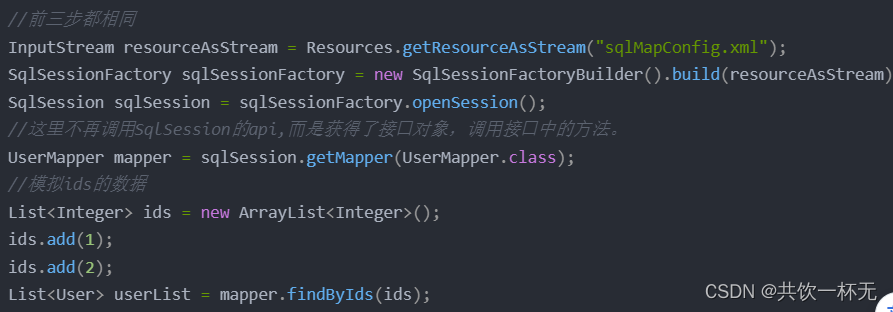MyBatis源码剖析之Mapper代理方式细节
MyBatis是一个流行的Java持久层框架,它提供了多种方式来执行数据库操作,其中之一就是通过Mapper代理方式。通过Mapper代理方式,开发者可以编写接口,然后MyBatis会动态地生成接口的实现类,从而避免了繁琐的SQL映射配置。
具体代码如下:

思考⼀个问题,通常的Mapper接⼝我们都没有实现的⽅法却可以使⽤,是为什么呢?
答案很简单:动态代理
public class Configuration { protected final MapperRegistry mapperRegistry = new MapperRegistry(this);}public class MapperRegistry { private final Map, MapperProxyFactory> knownMappers = new HashMap, MapperProxyFactory>();} 开始之前介绍⼀下MyBatis初始化时对接⼝的处理:MapperRegistry是Configuration中的⼀个属性,它内部维护⼀个HashMap⽤于存放mapper接⼝的⼯⼚类,每个接⼝对应⼀个⼯⼚类。mappers中可以配置接⼝的包路径,或者某个具体的接⼝类。

当解析mappers标签时,它会判断解析到的是mapper配置⽂件时,会再将对应配置⽂件中的增删改查标签 封装成MappedStatement对象,存⼊mappedStatements中。当判断解析到接⼝时,会建此接⼝对应的MapperProxyFactory对象,存⼊HashMap中,key =接⼝的字节码对象,value =此接⼝对应MapperProxyFactory对象。
源码剖析-getmapper()
进⼊ sqlSession.getMapper(UserMapper.class )中
public interface SqlSession extends Closeable { //调用configuration中的getMapper T getMapper(Class type);}public class DefaultSqlSession implements SqlSession { @Override public T getMapper(Class type) { //调用configuration 中的getMapper return configuration.getMapper(type, this); }}public class Configuration { public T getMapper(Class type, SqlSession sqlSession) { //调用MapperRegistry 中的getMapper return mapperRegistry.getMapper(type, sqlSession); }}public class MapperRegistry { @SuppressWarnings("unchecked") public T getMapper(Class type, SqlSession sqlSession) { //从 MapperRegistry 中的 HashMap 中拿 MapperProxyFactory final MapperProxyFactory mapperProxyFactory = (MapperProxyFactory) knownMappers.get(type); if (mapperProxyFactory == null) { throw new BindingException("Type " + type + " is not known to the MapperRegistry."); } try { //调用MapperProxyFactory的newInstance通过动态代理⼯⼚⽣成实例 return mapperProxyFactory.newInstance(sqlSession); } catch (Exception e) { throw new BindingException("Error getting mapper instance. Cause: " + e, e); } }}public class MapperProxyFactory { public T newInstance(SqlSession sqlSession) { //创建了 JDK动态代理的Handler类 final MapperProxy mapperProxy = new MapperProxy(sqlSession, mapperInterface, methodCache); //调⽤了重载⽅法 return newInstance(mapperProxy); } @SuppressWarnings("unchecked") protected T newInstance(MapperProxy mapperProxy) { return (T) Proxy.newProxyInstance(mapperInterface.getClassLoader(), new Class[] { mapperInterface }, mapperProxy); }}//MapperProxy 类,实现了 InvocationHandler 接⼝public class MapperProxy implements InvocationHandler, Serializable { //省略部分源码 private final SqlSession sqlSession; private final Class mapperInterface; private final Map methodCache; //构造,传⼊了 SqlSession,说明每个session中的代理对象的不同的! public MapperProxy(SqlSession sqlSession, Class mapperInterface, Map methodCache) { this.sqlSession = sqlSession; this.mapperInterface = mapperInterface; this.methodCache = methodCache; } //省略部分源码} 源码剖析-invoke()
在动态代理返回了示例后,我们就可以直接调⽤mapper类中的⽅法了,但代理对象调⽤⽅法,执⾏是在MapperProxy中的invoke⽅法中。
public class MapperProxy implements InvocationHandler, Serializable { @Override public Object invoke(Object proxy, Method method, Object[] args) throws Throwable { try { //如果是Object定义的⽅法,直接调⽤ if (Object.class.equals(method.getDeclaringClass())) { return method.invoke(this, args); } else if (isDefaultMethod(method)) { return invokeDefaultMethod(proxy, method, args); } } catch (Throwable t) { throw ExceptionUtil.unwrapThrowable(t); } // 获得 MapperMethod 对象 final MapperMethod mapperMethod = cachedMapperMethod(method); //重点在这:最终调⽤了MapperMethod执⾏的⽅法 return mapperMethod.execute(sqlSession, args); }} 进⼊execute⽅法:
public class MapperMethod { public Object execute(SqlSession sqlSession, Object[] args) { Object result; //判断mapper中的⽅法类型,最终调⽤的还是SqlSession中的⽅法 switch(command.getType()) switch (command.getType()) { case INSERT: { //转换参数 Object param = method.convertArgsToSqlCommandParam(args); //执⾏INSERT操作 //转换rowCount result = rowCountResult(sqlSession.insert(command.getName(), param)); break; } case UPDATE: { //转换参数 Object param = method.convertArgsToSqlCommandParam(args); // 转换 rowCount result = rowCountResult(sqlSession.update(command.getName(), param)); break; } case DELETE: { //转换参数 Object param = method.convertArgsToSqlCommandParam(args); // 转换 rowCount result = rowCountResult(sqlSession.delete(command.getName(), param)); break; } case SELECT: //⽆返回,并且有ResultHandler⽅法参数,则将查询的结果,提交给 ResultHandler 进⾏处理 if (method.returnsVoid() && method.hasResultHandler()) { executeWithResultHandler(sqlSession, args); result = null; //执⾏查询,返回列表 } else if (method.returnsMany()) { result = executeForMany(sqlSession, args); //执⾏查询,返回Map } else if (method.returnsMap()) { result = executeForMap(sqlSession, args); //执⾏查询,返回Cursor } else if (method.returnsCursor()) { result = executeForCursor(sqlSession, args); //执⾏查询,返回单个对象 } else { //转换参数 Object param = method.convertArgsToSqlCommandParam(args); //查询单条 result = sqlSession.selectOne(command.getName(), param); } break; case FLUSH: result = sqlSession.flushStatements(); break; default: throw new BindingException("Unknown execution method for: " + command.getName()); } //返回结果为null,并且返回类型为基本类型,则抛出BindingException异常 if (result == null && method.getReturnType().isPrimitive() && !method.returnsVoid()) { throw new BindingException("Mapper method '" + command.getName() + " attempted to return null from a method with a primitive return type (" + method.getReturnType() + ")."); } //返回结果 return result; }}总的来说,MyBatis的Mapper代理方式通过动态代理机制,将接口方法与SQL语句进行映射,使得开发者能够更加方便地进行数据库操作,同时避免了繁琐的SQL映射配置。这种方式使得代码更加清晰简洁,并且提供了良好的可扩展性和可维护性。
相关文章:
MyBatis插件原理探究和自定义插件实现
MyBatis源码剖析之Configuration、SqlSession、Executor、StatementHandler细节
本文内容到此结束了,
如有收获欢迎点赞👍收藏💖关注✔️,您的鼓励是我最大的动力。
如有错误❌疑问💬欢迎各位指出。
主页:共饮一杯无的博客汇总👨💻保持热爱,奔赴下一场山海。🏃🏃🏃
来源地址:https://blog.csdn.net/qq_35427589/article/details/132139755
免责声明:
① 本站未注明“稿件来源”的信息均来自网络整理。其文字、图片和音视频稿件的所属权归原作者所有。本站收集整理出于非商业性的教育和科研之目的,并不意味着本站赞同其观点或证实其内容的真实性。仅作为临时的测试数据,供内部测试之用。本站并未授权任何人以任何方式主动获取本站任何信息。
② 本站未注明“稿件来源”的临时测试数据将在测试完成后最终做删除处理。有问题或投稿请发送至: 邮箱/279061341@qq.com QQ/279061341














